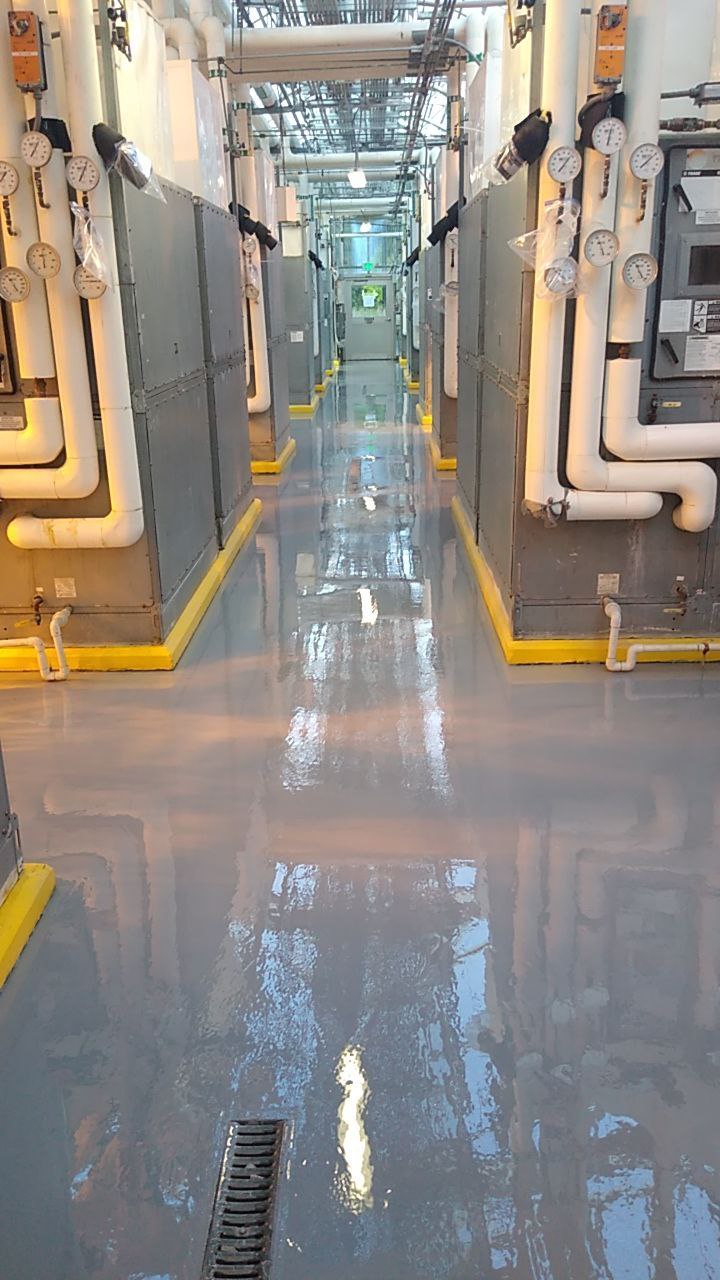posted by Custom Coatings, Inc. on October 15th, 2020
How much does it cost to paint my garage floor?
It’s the question we get most often about garage floors: How much does paint cost? And we could just tell you how we determine budgets job to job (it’s based on cost per square foot, if you must know). Instead however, at Custom Coatings, we’re all about client education (we’ve been coating garage floors since 1991; we know a bit about it), so we’d rather help you understand what’s included in that cost. Knowledge is power, and with it, you can make a more informed decision about your options and what contractor to use.
First, the best part: A properly installed and maintained garage floor coating system is a great thing to have. It can not only enhance the look of your garage, but add value to you home and make you smile every time you drive into it. So, nice choice. Now, let’s discuss what goes into creating that clean, smooth finish you’re dreaming of.
Generally, painting a garage floor involves four steps:
- Choosing a coating type (there are pros and cons and varying costs for each type)
- Moisture testing
- Floor preparation
- Floor cleaning
Step 1: Choose Your Coating Type
Garage floors are typically made of concrete. There are dozens if not hundreds of options for concrete coatings on the market from various manufacturers, but we’ll focus on what we consider the “Big 3.” These coating systems are the most popular, and offer homeowners a good amount of variety to choose from. They are:
- Solid color epoxy
- Broadcast or flake
- Concrete polishing
Solid color epoxy typically includes an epoxy base coat, epoxy intermediate coat and a urethane topcoat. Installing this type of system typically takes three days, and while you can walk on it after about 12 hours or overnight, you’ll want to wait a full three days for cars or heavy traffic. The cost is typically $4.50-$6.50 per square foot (though this depends a bit on the size of your garage, the condition of the concrete and how many joints to fill there might be). Pros: epoxy is really nice looking and reminds us of a “race shop.” It’s shiny, durable and easy to maintain. Cons: These floors can get slippery when they’re wet, and they’re not as visually interesting as broadcast floors.
Flake or broadcast floors are made by distributing flakes of quartz or quartz granules into a wet base coat that then are locked in place with an epoxy coating to and topped off with a protective urethane top coat. This floor is nicely non-slip, takes three days to complete (same rules on when you can walk and drive on it as the solid color epoxy), and typically costs $5.50-7.50 per square foot. Pros: This floor is really unique looking and has limitless color combinations. Cons: It’s harder to repair if damaged and costs a little more to purchase.
Concrete polishing is less of a coating as it is a methodology. A two-day process, concrete is ground down and polished up, then a densifier and stain protector is applied to help the look last. Polished concrete can be dyed, and you can choose luster levels from high shine to a more satin look (Lowe’s and Home Depot’s floors are polished but not very high shine, for example). These floors can be walked on immediately and driven on after 24 hours. They’re also economical: the typical cost is 3.50-$5.00 per square foot depending on size, the shine level, joints to be filled, repairs etc. Pros: These floors are neat looking (especially when dyed), are pretty trendy, and are super easy to maintain. Cons: They can stain somewhat more easily, wear patterns show faster, and they are very slippery when wet.
Step 2: Consider Your Materials Cost
When it comes to the cost of your floor coating of choice, as with many things, you get what you pay for. All major paint manufacturers have epoxy floor coating systems. So do all of the larger DIY retailers like Lowes and Home Depot. No matter the brand however, you’re going to find a few pricing tiers. Less expensive epoxy will most often not be as strong or durable as its more expensive counterparts. Because of the abuse a garage floor will take, you want to be sure you are buying a quality product specifically designed for the purpose. A good product will typically be easier to install and will perform better over time. Cheaper coating systems are thinner, tend to fail prematurely, and are more likely to be damaged by hot car tires. Materials costs can range from $1.00-2.50 per square foot, and better is definitely worth the cost.
Step 3: Tally Your Installation Cost
A three-coat coating system on a garage floor of around 700-800 square feet will require about three days to install. Polishing the same size area would take two to three days.
Of the Big 3 systems we’ve discussed above, solid color and broadcast floors are generally applied in the same manner. (Be sure to follow the manufacture’s recommended application rate, by the way – how many square feet per gallon to apply.)
When applying a solid epoxy system, you will put down the base coat and allow it to dry overnight or as recommended. If you are including a broadcast element like quartz, you will want to install the broadcast while the coating is still wet, so it will stick. The next day you can apply the intermediate coat. Be sure to check the manufacturer’s recommendations on re-coat time. Some epoxy coatings must be recoated within a certain time window or they will need to be sanded so the next coat can adhere. The third day you can apply the final coat. The cost to apply coatings is typically $1.50-3.00 per square foot.
Polishing concrete however requires specialized diamond tooling grinders and polishing a floor to a high-level shine can require 6-10 steps with each step creating a shinier surface. While polishing is generally faster than other coating methods, the diamond tooling and raises the installation cost of polished concrete to around 3.50-5.00 per square foot.
Step 4: Test for Moisture
The two basic moisture tests for garage floors are: 1) the plastic sheet method, and 2) the calcium chloride test. Why test? Too much moisture in your concrete will cause most coatings to fail. Typical tests measure moisture vapor transmission (MVT) – the amount of moisture traveling through or present in the concrete – and they’re fairly simple and not expensive. Cost for typical garage floor would be $20-100. We think it’s a small price to pay for an important step. Extra credit: For more information, take a look at this more in-depth article.
Step 5: Prep Your Floor
Preparing your floor is the most critical step to successfully installing a coating system. You can spend a million dollars on the paint, but if it does not properly adhere and fails, you’ve basically poured a bunch of expensive liquid down the drain.
Prep typically involves removing your concrete floor’s original sealant so your new coating can penetrate the surface. The most common ways to do this are:
Acid etching: .25-.50 per square foot, and typically not the best method. It can burn your eyes or skin, might cause metals in the garage area to rust, and is inconsistent. Heavier layers of acid will etch more. Lighter areas will etch less. It’s a little hard to control.
Shot blasting: 1.50-2.00 per square foot, and more reliable than acid etching, but requires experience to do correctly. Here, steel beads or “shot” are forced at high velocity onto the concrete to strip the surface. It’s a little tricky though: if your concrete is soft or you blast at the wrong angle or with too high a force, you can take a little too much off the top or create “corn rows” on your floor’s surface. In any case, with this method, you’ll want to apply a thicker base coat to smooth out any imperfections.
Grinding: 1.00-2.00 per square foot, and the best method (in our experience). Grinders utilize diamond tooling heads to profile the concrete and simply offer a better surface for coatings. Grinding is not damaging to the surface (like shot blasting can be), and removes more surface than acid etching, so it’s more reliable. Grinding may provide some leveling in high spots, but it won’t create corn rows or swirls. See www.icri.org for more info on concrete preparation and concrete surface profiles (CSP).
Step 6: Clean Clean Clean
Finally, before you get out the rollers and buckets, you will need to ensure that all dust and contaminants are removed from your floor. Dust you can rinse off with water, or you can use a floor scrubber (which agitates the dust and then sucks it up). We’d recommend the latter. Cleaning is pretty inexpensive and quick, but so vital. Cost: .20-.25 per square foot
Whether you decide to do it yourself or hire a professional, it’s important to be armed with the details. How much does coating a garage floor cost? It depends, but with some smart decisions and an understanding of the process, you can now make the best choice for your floor.
Have additional questions? We’re here to help. Contact us at info@customcoatingsinc.com or visit our website to fill out a contact form.
Happy painting!




